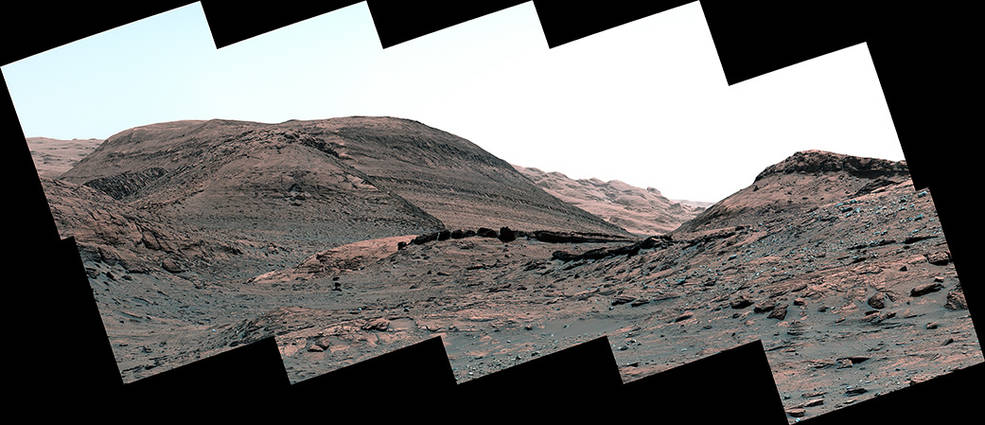NASA’s Curiosity Mars Rover Captures Stunning Views of a Changing Mars Landscape
Summary
[Curiosity is the biggest and most powerful rover ever launched to Mars. It was launched on November 26, 2011, and touched down on Mars on August 5, 2012. Curiosity had covered 21.8 km (13.5 miles) as of the year 2020. 2012 Robert J. Woodruff Prize was given to the NASA/JPL Mars Science Laboratory/Curiosity Project Team. As of today, June 23, 2022, the rover is still in use and has been operating on Mars for 3508 sols (3604 total days)].
Since last year, NASA’s Curiosity Mars rover has been moving through a zone that connects a region rich in clay to one that is rich in a saline mineral known as sulfate. The transition zone is proving to be equally as scientifically exciting as the clay-rich and sulfate-rich regions, which the science team focused on for the information they may each provide about Mars’ wet history.
In fact, this transition could serve as a record of a significant change in Mars’ climate that occurred billions of years ago and that researchers are only now beginning to understand.
NASA’s Curiosity Mars Rover
Curiosity is the biggest and most powerful rover ever launched to Mars. And it is a component of NASA’s Mars Science Laboratory project. It was launched on November 26, 2011, and touched down on Mars on August 5 at 10:32 p.m. PDT (1:32 a.m. EDT on Aug. 6, 2012).
Did Mars ever have the ideal environmental conditions to enable the existence of tiny living forms known as microbes? was the question Curiosity set out to investigate. Curiosity’s scientific instruments discovered chemical and mineral traces of previous habitable conditions on Mars early in the mission. It kept looking into the rock record from a time when microbial life might have existed on Mars.
Curiosity discovered that life might have existed on early Mars. Additionally, it discovered seasonal variations in the amount of methane in the Martian atmosphere. It also discovered signs of organic molecules preserved in rock layers that are 3.5 billion years old. In Gale crater, Curiosity had covered 21.8 km (13.5 miles) as of the year 2020.
As June 23, 2022, the rover is still in use and has been operating on Mars for 3508 sols (3604 total days; 9 years, 317 days) after its landing (see current status). The 2012 Robert J. Woodruff Prize was given to the NASA/JPL Mars Science Laboratory/Curiosity Project Team.
Curiosity Captures Stunning Views of a Changing Mars Landscape

Credits: NASA/JPL-Caltech/MSSS
- At one time, lakes and streams rippled throughout Gale Crater, depositing material at what is now the base of Mount Sharp, a mountain that rises to a height of three miles (five kilometers), and whose foothills Curiosity has been climbing since 2014. Higher on the mountain in the transition zone, Curiosity’s observations show that the streams dried into trickles and sand dunes formed above the lake sediments.
- Quoting Ashwin Vasavada, Curiosity’s project scientist at NASA’s Jet Propulsion Laboratory in Southern California as saying, NASA said, “We no longer see the lake deposits that we saw for years lower on Mount Sharp. “Instead, we see lots of evidence of drier climates, like dry dunes that occasionally had streams running around them. That’s a big change from the lakes that persisted for perhaps millions of years before”, added Vasavada.
- Less clay and more sulfate are being found by the rover as it passes upward through the transition zone. Soon, Curiosity will drill the final rock sample it will take in this region, offering a more thorough look at the shifting mineral makeup of these rocks.
- This region also stands out for its distinctive geologic features. The hills in the area probably started out as enormous, wind-swept sand dunes in a dry environment, eventually solidifying into granite. Other sediments carried by water and possibly deposited in ponds or tiny streams that once meandered amid the dunes are scattered among the fragments of these dunes. These sediments now resemble flaky layer stacks that are resistant to erosion, such as one known as “The Prow.”
- The information that groundwater fluctuated over time across several periods makes the story more interesting but also more challenging, creating a tangle of puzzle pieces for Curiosity’s scientists to piece together into a precise timeline.
Future of the NASA’s Curiosity Rover
On August 5, Curiosity will mark ten years on Mars. After a whole decade of exploration, the rover is beginning to show its age; but nothing has stopped it from continuing its ascent.
On June 7, Curiosity entered safe mode after noticing an instrument control box inside the rover’s body had a higher-than-expected temperature readout. When a spacecraft detects a problem, it instantly switches to safe mode, shutting down all but the most vital operations so that engineers may examine the situation.
The specific source of the problem is still being investigated by JPL experts even though Curiosity came out of safe mode and resumed normal operations two days later. There is no indication that safe mode will have a significant impact on rover operations. It’s because backup temperature sensors can make sure the electronics inside the rover body aren’t getting too hot. They believe that safe mode was activated because a temperature sensor provided an inaccurate measurement.
Aluminum wheels on the rover are also beginning to look worn. On June 4, the engineering team instructed Curiosity to take fresh images of its wheels, which it had been doing every 1,000 meters (3,281 feet), in order to assess their general condition.
The team found that one of Curiosity’s grousers, or the zig-zagging treads along its wheels, had been harmed by the left middle wheel. This particular wheel already had four broken grousers, so now five of its 19 grousers are broken.
The previously damaged grousers recently gained notice online because a gap appears to have developed where some of the metal “skin” between them may have come loose from the wheel in recent months.
What the Team has Done to Get it Back to the Original Cadence?
In order to get back to the original cadence, the team has chosen to increase wheel imaging to every 1,640 feet (500 meters). Wheel wear had been sufficiently reduced by a traction control algorithm to allow for an increase in the interval between images.
Megan Lin, Curiosity’s project manager at JPL says that they have proven through ground testing that they can safely drive on the wheel rims if necessary. “If we ever reached the point that a single wheel had broken a majority of its grousers, we could do a controlled break to shed the pieces that are left. Due to recent trends, it seems unlikely that we would need to take such action. The wheels are holding up well, providing the traction we need to continue our climb”, added Lin.
Curiosity has been a significant contributor to NASA’s Mars Science Laboratory mission.
Auto Amazon Links: No products found.

